Search Result
Results for "
sn-2
" in MedChemExpress (MCE) Product Catalog:
10
Biochemical Assay Reagents
1
Isotope-Labeled Compounds
| Cat. No. |
Product Name |
Target |
Research Areas |
Chemical Structure |
-
- HY-16696
-
SN 2
3 Publications Verification
|
Flavivirus
Dengue virus
TRP Channel
|
Infection
|
|
SN 2 is a potent activator of TRPML3 ion channel with an EC50 of 1.8 μM .
SN 2 also acts as a potent inhibitor of Dengue virus 2 (DENV2) and Zika virus (ZIKV) [2].
|
-
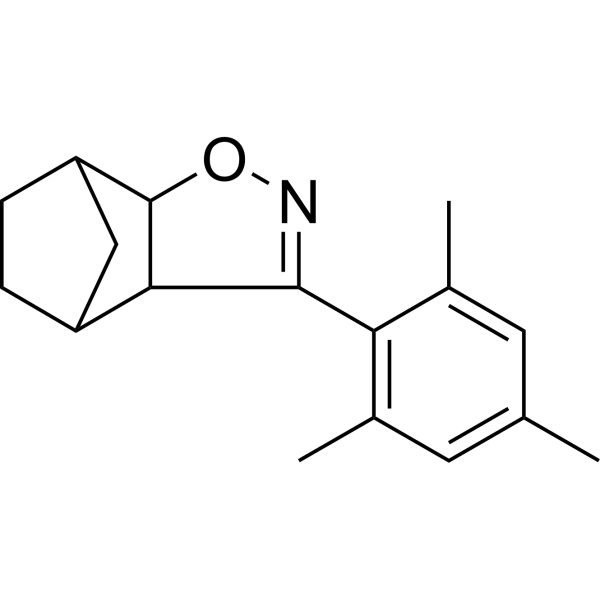
-
- HY-P3029
-
|
PLA2
|
Phospholipase
|
Others
|
|
Phospholipase A2 (PLA2) catalyzes the hydrolysis of the sn-2 position of membrane glycerophospholipids to liberate arachidonic acid (AA). Phospholipase A2 is a member of the class of heat-stable, calcium-dependent enzymes, is often used in biochemical studies .
|
-
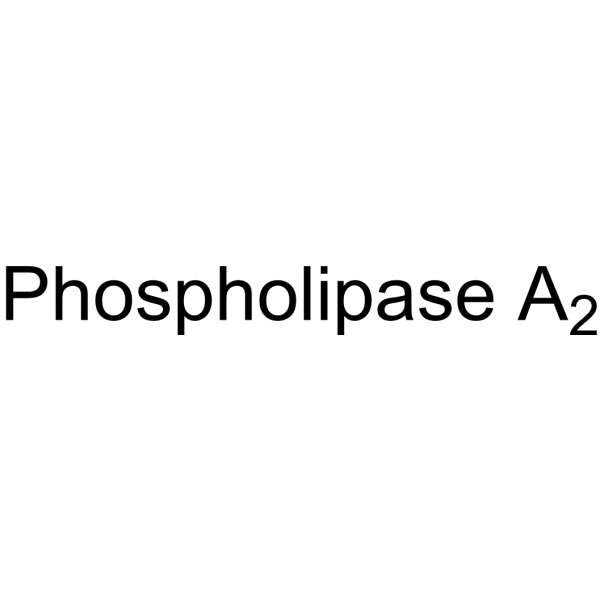
-
- HY-141642
-
|
Glycerol triheptadecanoate; Trimargarin
|
Others
|
Others
|
|
Triheptadecanoin is a triacylglycerol that contains heptadecanoic acid at the sn-1, sn-2, and sn-3 positions .
|
-

-
- HY-157742
-
|
|
Others
|
Others
|
|
1,3-Dioleoyl-2-elaidoyl glycerol (OEO) is a triacylglycerol. 1,3-Dioleoyl-2-elaidoyl glycerol can be used for the research of the effects of unsaturation and sn-2 substitution on the polymorphic behavior of triacylglycerols .
|
-

-
- HY-157741
-
|
|
Others
|
Others
|
|
1-Myristoyl-2-oleoyl-3-palmitoyl-rac-glycerol (MOP) is a triacylglycerol containing myristic acid (HY-N2041), oleic acid (HY-N1446) and palmitic acid (HY-N0830) at the sn-1, sn-2 and sn-3 positions, respectively .
|
-

-
- HY-145384
-
|
|
Phospholipase
|
Inflammation/Immunology
|
|
ROC-0929 (compound 13a) is a potent and selective inhibitor of secreted phospholipases A2 (sPLA2s) with an IC50 of 80 nM, specially targeting hGX. ROC-0929 inhibits the phosphorylation of ERK1/2 and p-38. Secreted phospholipases A2 (sPLA2s) are a family of disulfide-rich, Ca 2+-dependent enzymes that hydrolyze the sn-2 position of glycero-phospholipids to release a fatty acid and a lysophospholipid. ROC-0929 has the potential for researching inflammation related diseases .
|
-
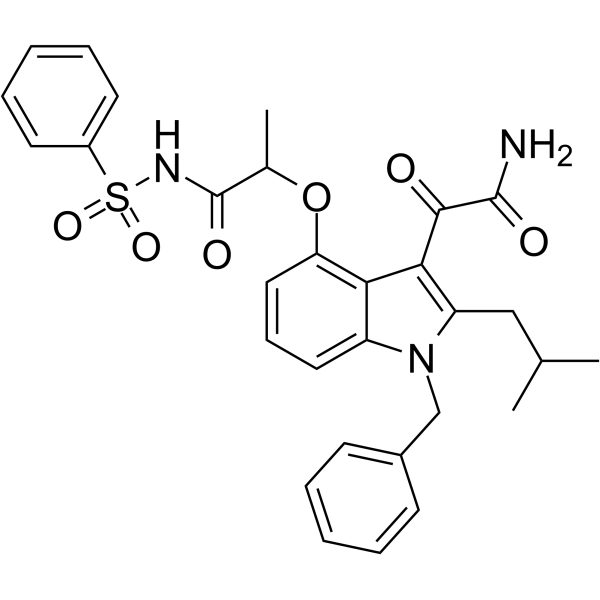
-
- HY-W704966
-
|
18:0 Lyso-PC; LPC(18:0); PC(0:0/18:0)
|
Endogenous Metabolite
|
Metabolic Disease
|
|
2-Stearoyl-sn-glycero-3-PC is a lysophospholipid that contains stearic acid (HY-B2219) at the sn-2 position. It has been found in rabbit myocardium.
|
-

-
- HY-141571
-
|
|
Liposome
|
Others
|
|
DOPG sodium is a phospholipid containing oleic acid (18:1) inserted at the sn-1 and sn-2 positions. It can form a lipid bilayer in an aqueous solution and is used in the generation of micelles, liposomes, and other artificial membranes.
|
-
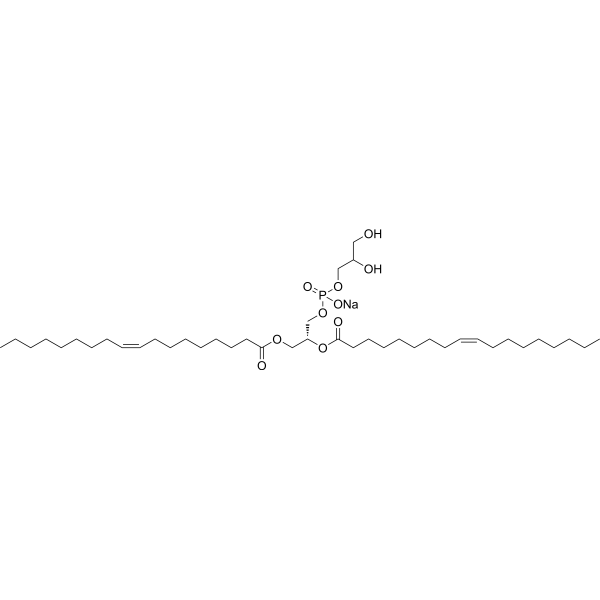
-
- HY-W019833
-
|
PC(14:0/18:0); 1-Myristoyl-2-stearoyl-sn-glycero-3-phosphocholine
|
Endogenous Metabolite
|
Metabolic Disease
|
|
MSPC is an asymmetrical phosphatidylcholine containing a myristic acid (14:0) at the sn-1 position and a stearic acid (18:0) at the sn-2 position. It can self assemble in water to form lipid bilayers. Reagent grade, for research purpose.
|
-
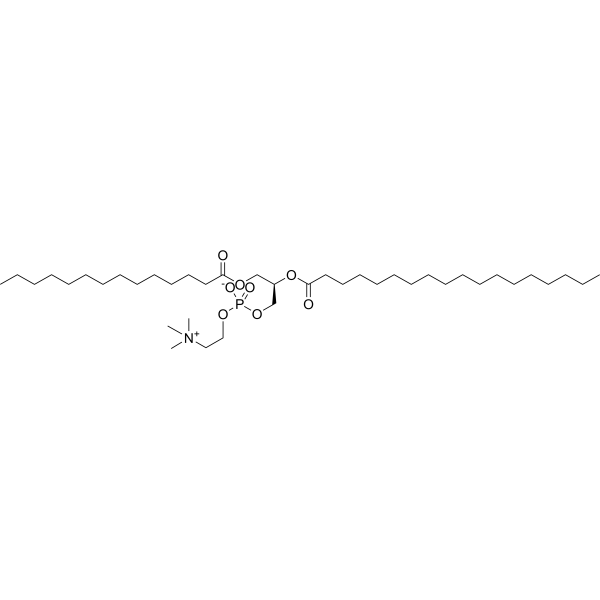
-
- HY-W725327
-
|
1,2-Dipropionyl-sn-glycero-3-Phosphatidylcholine; 1,2-Dipropionyl-sn-glycero-3-Phosphocholine; PC(3:0/3:0)
|
Endogenous Metabolite
|
Metabolic Disease
|
|
1,2-Dipropionyl-sn-glycero-3-PC is a phospholipid containing propionic acid at the sn-1 and sn-2 positions. It has been used to study the interaction between water and the phosphocholine headgroup in aqueous solutions.
|
-

-
- HY-W440982
-
|
PC(18:0/18:1); 2-?Oleoyl-?1-?stearoyl-?sn-?glycero-?3-?phosphocholine
|
Liposome
|
Others
|
|
SOPC is an asymmetrical phospholipid with saturated fatty acid (stearic acid/18:0) at sn-1 position and unsaturated fatty acid (oleic acid/18:1) at sn-2 position. SOPC can be used for various biochemical studies .
|
-
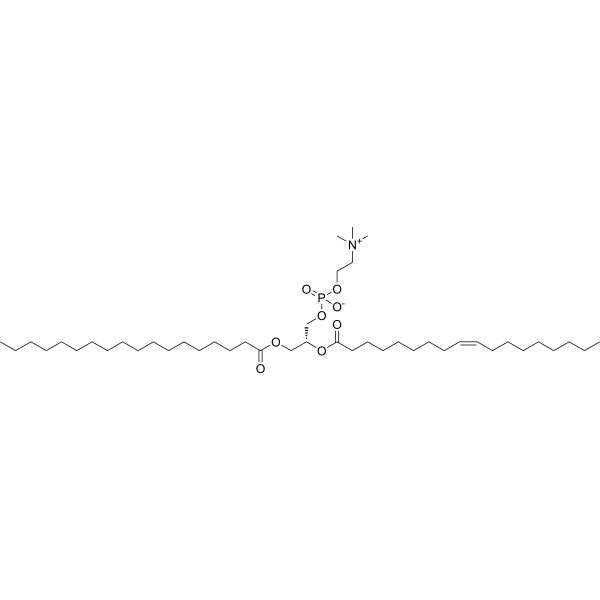
-
- HY-125744
-
|
|
Biochemical Assay Reagents
|
Others
|
|
Palmitoyl thio-PC is a chromogenic substrate specific for PLA2 with a palmitoyl thioester at the sn-2 position. Palmitoyl thio-PC could be used to measure bee-venom sPLA2 activity in a phospholipid:Triton X-100 mixed micelle system .
|
-
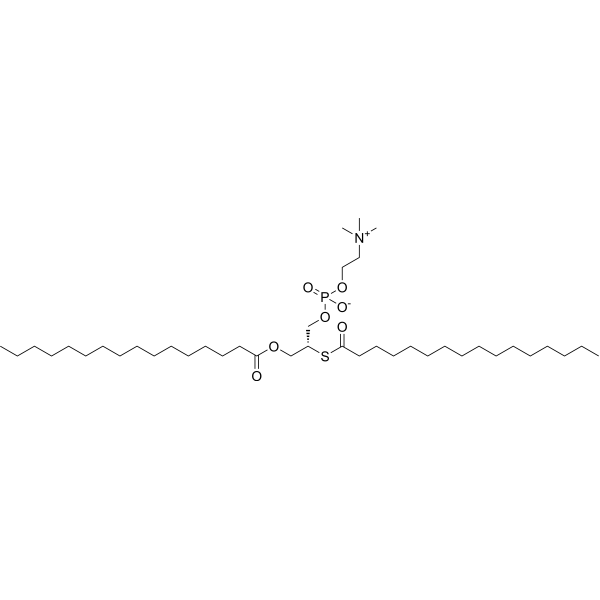
-
- HY-W440983
-
|
PC(18:0/22:6); DHA-PC; 1-Stearoyl-2-docosahexaenoyl-sn-glyerco-3-phosphocholine
|
PPAR
|
Cardiovascular Disease
Cancer
|
|
SDPC (DHA-PC) is a new generation of omega-3 lipids, which contains an ester bond linking DHA at the sn-2 position of phospholipid. 1-Stearoyl-2-docosahexaenoyl-sn-glyerco-3-phosphocholine exerts anti-angiogenesis effect through activating PPARγ. 1-Stearoyl-2-docosahexaenoyl-sn-glyerco-3-phosphocholine significantly declines the proliferation, migration, tube formation of human umbilical vein endothelial cells. 1-Stearoyl-2-docosahexaenoyl-sn-glyerco-3-phosphocholine has the potential for anti-tumor angiogenesis research .
|
-

-
- HY-145541
-
|
1,2-Dinonadecanoin
|
Biochemical Assay Reagents
|
Others
|
|
12-Dinonadecanoyl-rac-glycerol is a diacylglycerol containing nonadecanoic acid (HY-W004261) at the sn-1 and sn-2 positions. Nonadecanoic acid is a 19-carbon long saturated fatty acid. Nonadecanoic acid is the major constituent of the substance secreted by Rhinotermes marginalis to defence .
|
-

-
- HY-125940
-
|
|
Liposome
|
Others
|
|
DPPG sodium (1,2-Dipalmitoyl-sn-glycero-3-PG sodium) is a phospholipid containing the long-chain(16:0) palmitic acid inserted at the sn-1 and sn-2 positions. DPPG sodium is used in the generation of micelles, liposomes and other types of artificial membranes .
|
-
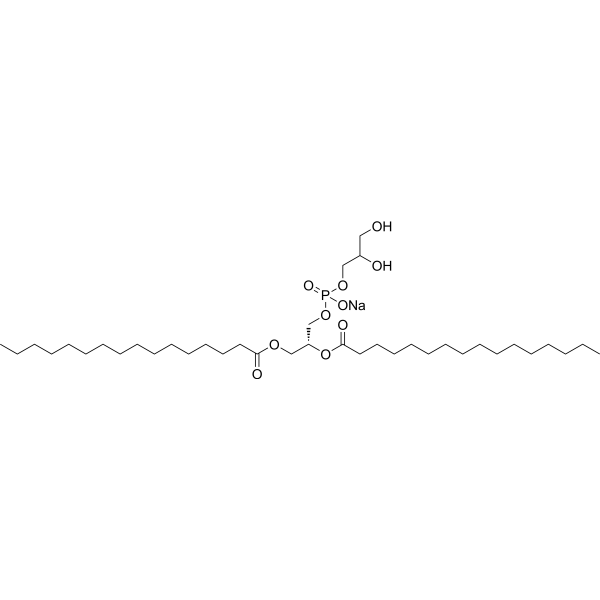
-
- HY-N7953
-
|
OOL; TG(18:1/18:1/18:2); TG(54:4)
|
Endogenous Metabolite
|
Metabolic Disease
|
|
1,2-Dioleoyl-3-linoleoyl-rac-glycerol (OOL) is a triacylglycerol containing oleic acid at the sn-1 and sn-2 positions and linoleic acid at the sn-3 position. It is found in a variety of seed and vegetable oils, including pumpkin seed, olive, and sesame oils.
|
-

-
- HY-125940S
-
|
|
Isotope-Labeled Compounds
|
Others
|
|
DPPG-d62 (sodium) is deuterium labeled DPPG. DPPG sodium (1,2-Dipalmitoyl-sn-glycero-3-PG sodium) is a phospholipid containing the long-chain(16:0) palmitic acid inserted at the sn-1 and sn-2 positions. DPPG sodium is used in the generation of micelles, l
|
-
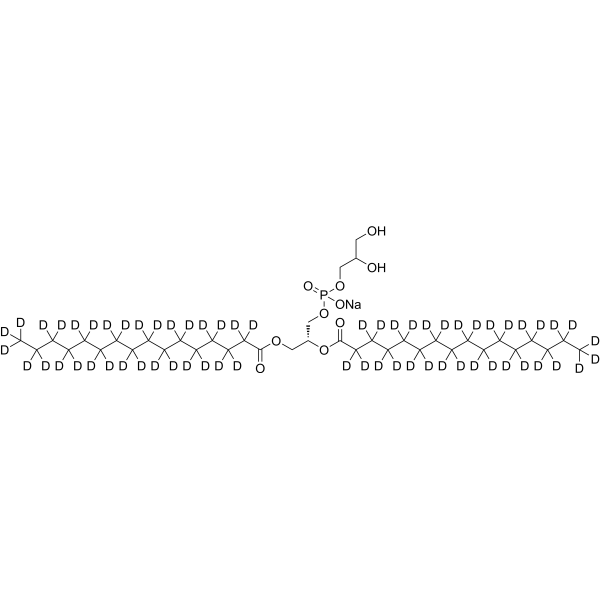
-
- HY-142974
-
|
1,2-Olein-3-Docosohexaenoin; 18:1/18:1/22:6-TG; C1OO
|
Endogenous Metabolite
|
Metabolic Disease
|
|
1,2-Dioleoyl-3-docosohexaenoyl-rac-glycerol is a triacylglycerol that contains oleic acid (HY-N1446) at the sn-1 and sn-2 positions and docosahexaenoic acid (HY-B2167) at the sn-3 position. It has been detected in human breast milk.
|
-

-
- HY-157698
-
|
C18(plasm)-20:4-PC; 18:0p/20:4-PC; PC(P-18:0/20:4)
|
Endogenous Metabolite
|
Metabolic Disease
|
|
1-1(Z)-Octadecenyl-2-arachidonoyl-sn-glycero-3-PC is a plasmalogen that contains 1(Z)-octadecenoic acid and arachidonic acid (HY-109590) at the sn-1 and sn-2 positions, respectively. It scavenges singlet oxygen in a cell-free assay.
|
-

-
- HY-W710380
-
|
1,2-Stearin-3-Olein; TG(18:0/18:0/18:1)
|
Endogenous Metabolite
|
Metabolic Disease
|
|
1,2-Distearoyl-3-oleoyl-rac-glycerol is a triacylglycerol that contains stearic acid (HY-B2219) at the sn-1 and sn-2 positions and oleic acid (HY-N1446) at the sn-3 position. It has been found in cocoa butter and vegetable oils.
|
-

-
- HY-W704603
-
|
1,2-Olein-3-Stearin; TG(18:1/18:1/18:0)
|
Endogenous Metabolite
|
Metabolic Disease
|
|
1,2-Dioleoyl-3-stearoyl-rac-glycerol is a triacylglycerol that contains oleic acid (HY-N1446) at the sn-1 and sn-2 positions and stearic acid (HY-B2219) at the sn-3 position. It has been found in sunflower, corn, and soybean oils, as well as ostrich oil.
|
-

-
- HY-145522
-
|
MEM; 1,3-Myristin-2-Eicosapentaenoin; 14:0/20:5/14:0-TG
|
Others
|
Metabolic Disease
|
|
1,3-Dimyristoyl-2-eicosapentaenoyl glycerol (MEM) is a triacylglycerol that contains myristic acid (HY-N2041) at the sn-1 and sn-3 positions and eicosapentaenoic acid at the sn-2 position. The myristoyl groups in MEM do not affect the oxidative stability of eicosapentaenoic acid (EPA) during long-term storage at 25°C.
|
-

-
- HY-W706672
-
|
Glycerol Tritricosanoate; TG(23:0/23:0/23:0); Tritricosanoin
|
Endogenous Metabolite
|
Metabolic Disease
|
|
1,2,3-Tritricosanoyl glycerol is a triacylglycerol that contains tricosanoic acid (HY-W009081) at the sn-1, sn-2, and sn-3 positions. It has been used as an internal standard for the quantification of fatty acids in the triglyceride component of human aortic endothelial cells (HAECs) grown in media supplemented with stearic and/or oleic acid.
|
-

-
- HY-W674124
-
|
TG(15:0/15:0/15:0); 1,2,3-Tripentadecanoyl glycerol
|
Others
|
Others
|
|
Tripentadecanoin (TG(15:0/15:0/15:0)) is a triacylglycerol that contains pentadecanoic acid (HY-W004283) at the sn-1, sn-2, and sn-3 positions. It has been found in various grapes. 1,2,3-Tripentadecanoyl glycerol has been used as a standard for the detection of triacylglycerols in human plasma by LC-MS.
|
-

-
- HY-W704597
-
|
1-Palmitin-2-Olein-3-Stearin; TG(16:0/18:1/18:0)
|
Endogenous Metabolite
|
Metabolic Disease
|
|
1-Palmitoyl-2-oleoyl-3-stearoyl-rac-glycerol is a triacylglycerol that contains palmitic acid (HY-N0830) at the sn-1 position, oleic acid (HY-N1446) at the sn-2 position, and stearic acid (HY-B2219) at the sn-3 position. It is one of the primary triacylglycerols found in cocoa butter.
|
-

-
- HY-134154
-
|
PAzePC; Azelaoyl PC; 1-Palmitoyl-2-Azelaoyl PC
|
Endogenous Metabolite
|
Metabolic Disease
|
|
Oxidized low-density lipoprotein (oxLDL) particles contain low molecular weight species which are cytotoxic and pro-atherogenic. Many of these substances were isolated and purified from oxLDL and identified as phosphatidylcholine species containing a fragmented, oxidized short-chain fatty acid remnant at the sn-2 position. PAz-PC (Azelaoyl PC) is one of the predominant oxLDL species and may be one of the important structural determinants of oxLDL.
|
-

-
- HY-142971
-
|
1-Myristin-2-Linolein-3-Olein; TG(14:0/18:2/18:1)
|
Endogenous Metabolite
|
Metabolic Disease
|
|
1-Myristoyl-2-linoleoyl-3-oleoyl-rac-glycerol is a triacylglycerol that contains myristic acid (HY-N2041), linoleic acid (HY-N0729), and oleic acid (HY-N1446) at the sn-1, sn-2, and sn-3 positions, respectively. It has been found in mature human milk, infant formula fats, and butterfat.
|
-

-
- HY-W643167
-
|
Glycerol Tritridecanoyl; 13:0 TAG; 13:0/13:0/13:0-TG
|
Others
|
Infection
|
|
1,2,3-Tritridecanoyl glycerol is a synthetic triacylglycerol that contains tridecanoic acid in the sn-1, sn-2, and sn-3 positions. It has been used as a standard for the relative quantification of triacylglycerols in C. elegans fat stores. It has also been used as an internal standard for the quantification of triacylglycerols in the serum and liver of adult rat offspring receiving dietary conjugated linoleic acids during and after gestation.
|
-

-
- HY-157697
-
|
18:0p/20:4-PE; C18(Plasm)-20:4-PE; PE(P-18:0/20:4)
|
Endogenous Metabolite
|
Metabolic Disease
|
|
1-1(Z)-Octadecenyl-2-arachidonoyl-sn-glycero-3-PE (18:0p/20:4-PE; C18(Plasm)-20:4-PE) is a plasmalogen that contains 1(Z)-octadecenoic acid and arachidonic acid (HY-109590) at the sn-1 and sn-2 positions, respectively.
|
-

-
- HY-W127380
-
|
|
Biochemical Assay Reagents
|
Others
|
|
Arachidonoyl Thio-PC is a substrate of many phospholipase A2 (PLA2), including sPLA2, cPLA2 and iPLA2. Cleavage of sn-2 fatty acids by PLA2 results in the production of free thiols, which react with chromogenic reagents such as DTNB (Ellman's reagent) and DTP, allowing quantification of PLA2 activity. Isozyme-specific cPLA2 activity can be measured by depleting or inhibiting sPLA2 and iPLA2 activity in the assay.
|
-

-
- HY-W127408
-
|
|
Biochemical Assay Reagents
|
Others
|
|
1,2,3-Tripalmitoleoyl-rac-glycerol is a triacylglycerol containing palmitoleic acid at the sn-1, sn-2 and sn-3 positions. It reduces erythrocyte deformability in a concentration-dependent manner in the Reid filtration assay. Hepatic levels of 1,2,3-tripalmitoleoyl-rac-glycerol are increased in a JAK2L mouse model of hepatic steatosis. 1,2,3-Tripalmitoleoyl-rac-glycerol plasma levels are reduced in patients with predialysis renal disease.
|
-
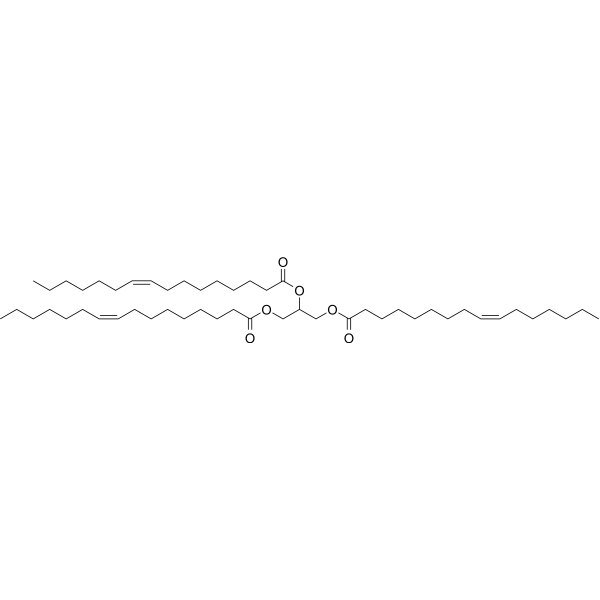
-
- HY-117168
-
|
|
Endogenous Metabolite
|
Metabolic Disease
|
|
1,2-Dilinoleoyl-sn-glycerol is a diacylglycerol (DAG) with linoleic acid (HY-N0729) (18:2) side chains attached at both the sn-1 and sn-2 positions. It has been found as a component of phosphatidic acid in rat liver mitochondria and in spinach chloroplast membranes. 1,2-Dilinoleoyl-sn-glycerol is upregulated in some pregnant women and has been used as a biomarker to predict later preeclampsia in early pregnancy.
|
-

-
- HY-145545
-
|
PE(18:0/22:4); 1-Stearoyl-2-Docosatraenoyl-sn-glycero-3-PE
|
Endogenous Metabolite
|
Metabolic Disease
|
|
1-Stearoyl-2-adrenoyl-sn-glycero-3-PE is a phospholipid that contains stearic acid (HY-B2219) and adrenic acid (HY-W013215) at the sn-1 and sn-2 positions, respectively. 1-Stearoyl-2-adrenoyl-sn-glycero-3-PE levels are inversely correlated with subject age in mitochondria isolated from human post-mortem hippocampus.
|
-

-
- HY-W010667
-
|
1,3-Dipalmitoyl-2-oleoylglycerol; ?1,3-Palmitin-2-Olein; TG(16:0/18:1/16:0)
|
Endogenous Metabolite
|
Metabolic Disease
|
|
1,3-Dipalmitoyl-2-oleoyl glycerol (1,3-Palmitin-2-Olein; TG(16:0/18:1/16:0)) is a triacylglycerol that contains palmitic acid (HY-N0830) at the sn-1 and sn-3 positions and oleic acid (HY-N1446) at the sn-2 position. It has been found in cocoa butter, Chinese tallow butter, and the palm stearin fraction of palm oil.
|
-

-
- HY-141636
-
|
1-Palmitoyl-2-arachidonoyl-sn-glycero-3-phosphocholine; PAPC; PC(16:0/20:4)
|
Others
|
Cardiovascular Disease
|
|
1-Palmitoyl-2-arachidonoyl-sn-glycero-3-PC (PAPC) is a phospholipid containing palmitic acid (16:0) and arachidonic acid (20:4) at the sn-1 and sn-2 positions, respectively, that is found in biological membranes. PAPC is oxidized in vivo, and its oxidation products are involved in chronic inflammation and vascular disease. PAPC has been used to study signaling of oxidized phospholipids. Levels of PAPC are decreased in isolated human multiple myeloma cells.
|
-

-
- HY-126726
-
|
|
Biochemical Assay Reagents
|
Others
|
|
Oxidized low-density lipoprotein (oxLDL) particles contain low molecular weight species that are cytotoxic and proatherogenic. Many of these species were recently isolated and purified from oxLDL and identified as phosphatidylcholine species containing fragmented oxidized short-chain fatty acid residues at the sn-2 position. 1-(Palmitoyl)-2-(5-keto-6-octene-dioyl)phosphatidylcholine or KOdiA-PC is one of the most potent CD36 ligands of the oxLDL species. KOdiA-PC confers CD36 scavenger receptor binding affinity to LDL at a frequency of only 2 to 3 KOdiA-PC molecules/LDL particle and may be one of the more important structural determinants of oxLDL.
|
-
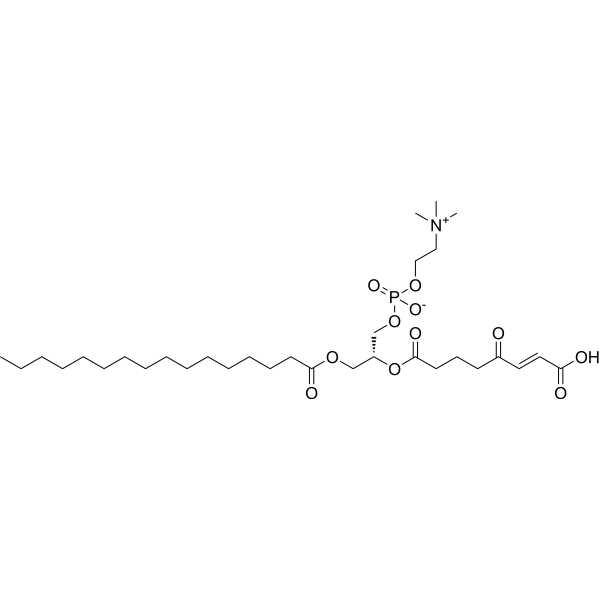
-
- HY-145540
-
|
1,2-Palmitin-3-caprylin
|
Biochemical Assay Reagents
|
Metabolic Disease
|
|
1,2-Dipalmitoyl-3-Octanoyl-rac-glycerol is a triacylglycerol containing palmitic acid (HY-N0830) at the sn-1 and sn-2 positions and octanoic acid (HY-41417) at the sn-3 position. Palmitic acid is a long-chain saturated fatty acid commonly found in both animals and plants. PA can induce the expression of glucose-regulated protein 78 (GRP78) and CCAAT/enhancer binding protein homologous protein (CHOP) in in mouse granulosa cells. Octanoic acid is an oily liquid with a slightly unpleasant rancid taste and used commercially in the production of esters used in perfumery and also in the manufacture of dyes. Octanoic acid is also a tremor-suppressing agent [2] .
|
-
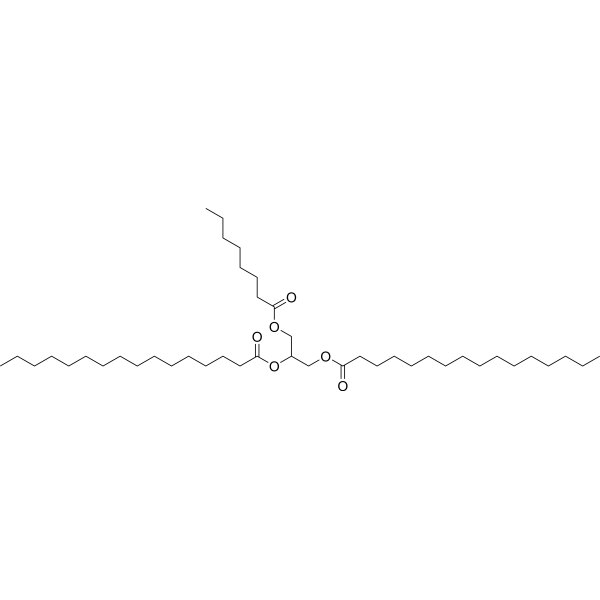
-
- HY-W127357
-
|
|
Biochemical Assay Reagents
|
Others
|
|
Glyceryl trinonanoate is a triacylglycerol containing nonanoic acid at the sn-1, sn-2 and sn-3 positions. It has been found in Schizochytrium biomass. 1 1,2,3-Trinonanoyl-rac-glycerol increases blood levels of the ketone body D-(-)-3-hydroxybutyrate in neonatal rhesus monkeys. 2|1. Mioso, R., Toledo Marante, FJ, González, JE, et al. Schizochytrium sp. metabolite analysis. Oleaginous microbial sources of biodiesel by GC-MS. braz. J. Microbiology. 45(2), 403-409 (2014).|2. Tetrick, MA, Greer, FR and Benevenga, NJ Blood D- ( )-3-Hydroxybutyric acid concentration. Compare. medicine. 60(6), 486-490 (2010).
|
-
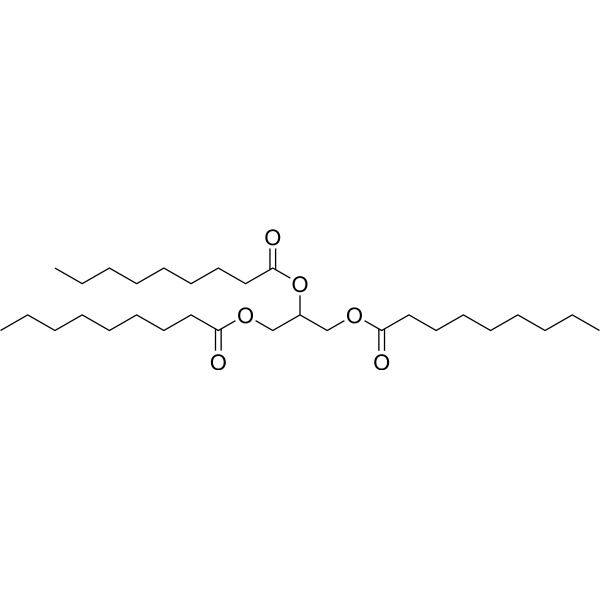
-
- HY-145504
-
|
1,2-Palmitin-3-Linoelaidin
|
Biochemical Assay Reagents
|
Metabolic Disease
|
|
12-Dipalmitoyl-3-Linoelaidoyl-rac-glycerol is a triacylglycerol containing palmitic acid (HY-N0830) at the sn-1 and sn-2 positions and linoelaidic acid (HY-W071746) at the sn-3 position. Palmitic acid is a long-chain saturated fatty acid commonly found in both animals and plants. Palmitic acid can induce the expression of glucose-regulated protein 78 (GRP78) and CCAAT/enhancer binding protein homologous protein (CHOP) in in mouse granulosa cells. Linolelaidic acid, an omega-6 trans fatty acid, acts as a source of energy. Linolelaidic acid is an essential nutrient, adding in enteral, parenteral, and infant formulas. Linolelaidic acid can be used for heart diseases research [2] .
|
-
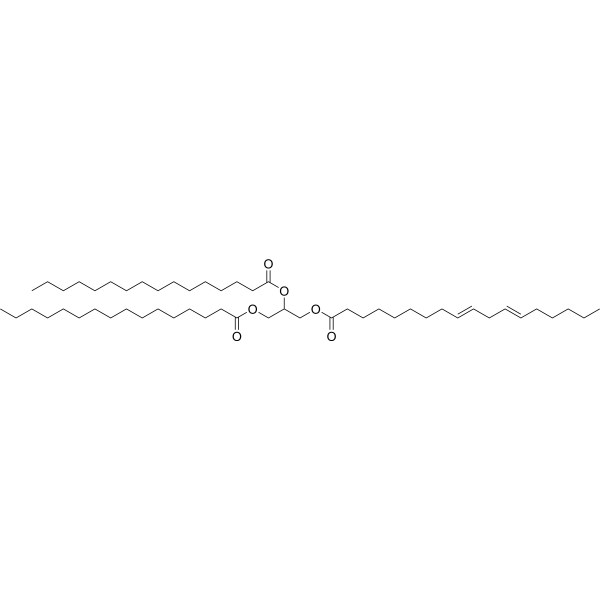
-
- HY-145473
-
|
15(S)-HETE-SAPE; 15(S)-Hydroxyeicosatetraenoic acid-SAPE; 1-Stearoyl-2-15(S)-HETE-sn-glycero-3-Phosphatidylethanolamine
|
Others
|
Metabolic Disease
|
|
1-Stearoyl-2-15(S)-HETE-sn-glycero-3-PE is a phospholipid that contains stearic acid (HY-B2219) at the sn-1 position and 15(S)-HETE at the sn-2 position. It is formed in human peripheral monocytes activated by the calcium ionophore A23187 (HY-N6687) by direct oxidation of 1-stearoyl-2-arachidonoyl-sn-glycero-3-PE (SAPE) by 15-LO. Phosphoethanolamine (PE) HETEs (PE-HETEs), including 1-stearoyl-2-15(S)-HETE-sn-glycero-3-PE, are the main source of esterified HETE in ionophore-activated monocytes.
|
-

-
- HY-156041
-
|
Lyso-PE (egg); LPE (egg); L-α-lysophosphatidylethanolamine
|
Endogenous Metabolite
|
Metabolic Disease
|
|
Lysophosphatidylethanolamine (LPE) is a naturally-occurring lysophospholipid that can be generated via deacylation of phosphatidylethanolamine by phospholipase A2 (PLA2). It increases the phosphorylation of ERK1/2 in PC12 cells, an effect that can be blocked by the MEK inhibitors U-0126 (HY-12031A) and PD 98059 (HY-12028) and the EGFR inhibitor AG-1478 (HY-13524).1 LPE also increases neurite outgrowth and expression of neurofilament M in PC12 cells. LPE inhibits the activity of phospholipase D (PLD) partially purified from cabbage.3 This product contains lysophosphatidylethanolamine molecular species with variable fatty acyl chain lengths at the sn-1 position and a hydroxy group at the sn-2 position.
|
-

-
- HY-112747
-
|
LPI; PE (soy)
|
Phospholipase
|
Infection
|
|
Phosphatidylethanolamine is the most abundant phospholipid in prokaryotes and the second most abundant found in the membrane of mammalian, plant, and yeast cells, comprising approximately 25% of total mammalian phospholipids. In the brain, phosphatidylethanolamine comprises almost half of the total phospholipids. It is synthesized mainly through the cytidine diphosphate-ethanolamine and phosphatidylserine decarboxylation pathways, which occur in the endoplasmic reticulum (ER) and mitochondrial membranes, respectively. It is a precursor in the synthesis of phosphatidylcholine and arachidonoyl ethanolamide and is a source of ethanolamine used in various cellular functions. In E. coli, phosphatidylethanolamine deficiency prevents proper assembly of lactose permease, suggesting a role as a lipid chaperone. It is a cofactor in the propagation of prions in vitro and can convert recombinant mammalian proteins into infectious molecules even in the absence of RNA. This product contains phosphatidylethanolamine molecular species with variable fatty acyl chain lengths at the sn-1 and sn-2 positions.
|
-

-
- HY-115701
-
|
1-Stearoyl-2-15(S)-HpETE-sn-glycero-3-phosphoethanolamine; 15(S)-HpETE-SAPE; 15(S)-hydroperoxyeicostetraenoic acid-SAPE
|
Others
|
Inflammation/Immunology
|
|
1-Stearoyl-2-15(S)-HpETE-sn-glycero-3-Pe is a phospholipid that contains stearic acid (HY-B2219) at the sn-1 position and 15(S)-HpETE at the sn-2 position. It is produced via oxidation of 1-stearoyl-2-arachidonoyl-sn-glycero-3-Pe (SAPE) by 15-lipoxygenase (15-LO). 1-Stearoyl-2-15(S)-HpETE-sn-glycero-3-Pe (0.6 and 0.9 μM) increases ferroptotic cell death in wild-type and Acsl4 knockout Pfa1 mouse embryonic fibroblasts (MEFs) treated with the GPX4 inhibitor RSL3.
|
-

-
- HY-W127391
-
|
(Rac)-1,2-Didodecanoylglycerol
|
Biochemical Assay Reagents
|
Others
|
|
1,2-Dilaurin is a diacylglycerol containing lauric acid at the sn-1 and sn-2 positions. It has been used as an internal standard for the quantification of diglycerides in rat desheathed sciatic nerves. [1] Monomolecular films containing 1,2-dilauroyl-rac-glycerol have been used as substrates to measure surface pressure and the effect of pancreatic procolipase and colipase on porcine pancreatic lipase activity. [2] References: [1]. Zhu, X. and Eichberg, J. 1,2-Diacylglycerol content and its arachidonyl-containing molecular species are reduced in the sciatic nerve of streptozotocin-induced diabetic rats. J. Neurochemistry. 55(3), 1087-1090 (1990).[2]. Wieloch, T., Borgstr m, B., Piéroni, G. et al. Porcine trypsinogen and its trypsin-activated form: lipid binding and lipase activation on monomolecular membranes. FEBS Express. 128(2), 217-220 (1981).
|
-
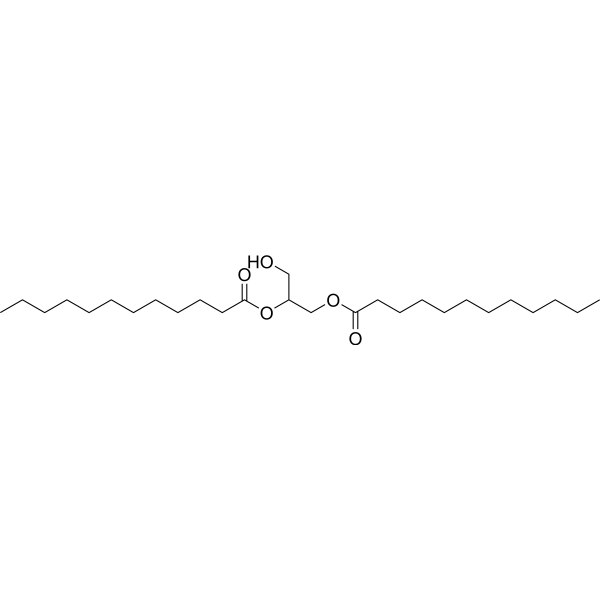
-
- HY-W010736A
-
|
|
Biochemical Assay Reagents
|
Others
|
|
1,2-Dipalmitoyl-rac-glycerol is a diacylglycerol containing palmitic acid at the sn-1 and sn-2 positions (Cat. No. 10006627). It is found in a variety of vegetable oils, including palm, soybean, canola, and corn. 1 \n 1,2-Dipalmitoyl-rac-glycerol MaxSpec Standard is a quantitative grade standard of 1,2-dipalmitoyl-rac-glycerol prepared for mass spectrometry and related applications requiring quantitative reproducibility . The solution has been prepared gravimetrically and contained in argon-sealed deactivated glass ampoules. Concentrations were verified by comparison to independently prepared calibration standards. This 1,2-dipalmitoyl-rac-glycerol MaxSpec Standard is guaranteed to meet specifications for identity, purity, stability, and concentration and is supplied with a batch-specific Certificate of Analysis. Ongoing stability testing is performed to ensure concentrations remain accurate throughout the shelf life of the product. Note: Add more solution to the vial than listed. Therefore, accurate volume measurements are necessary to prepare calibration standards. Follow recommended storage and handling conditions to maintain product quality.
|
-
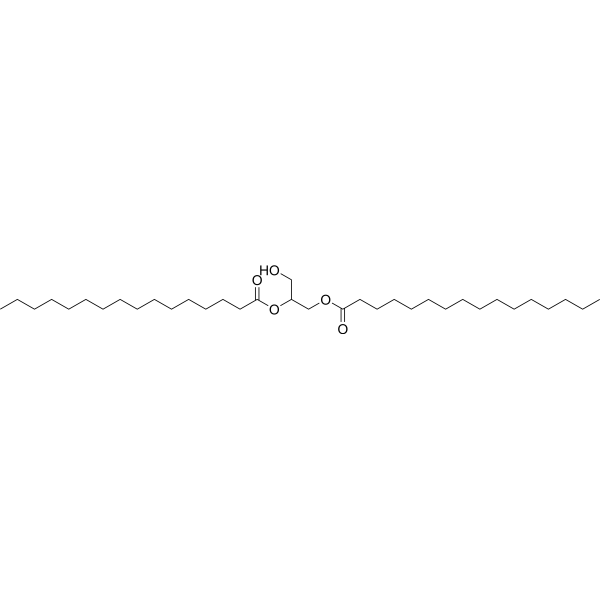
-
- HY-W251428
-
|
Egg PG
|
Biochemical Assay Reagents
|
Others
|
|
Phosphatidylglycerol is a naturally occurring anionic phospholipid that is a component of plant, animal and bacterial cell membranes. It is present in prokaryotes and eukaryotes less than phosphatidylethanolamine, and in eukaryotes less than phosphatidylcholine. It is formed by the reaction between CDP-diglyceride and L-α-glycerol 3-phosphate followed by dephosphorylation and is the metabolic precursor of cardiolipin. Phosphatidylglycerols containing polyunsaturated and monounsaturated fatty acyl chains inhibit and promote the proliferation of murine keratinocytes, respectively. Phosphatidylglycerol is the second-largest lipid component of mammalian lung surfactant, accounting for 10% of lipids, and has reduced levels of pulmonary surfactant in infants with respiratory distress syndrome. Phosphatidylglycerol (egg) is a mixture of phosphatidylglycerols isolated from eggs with various fatty acyl groups at the sn-1 and sn-2 positions. References: [1]. Ohtsuka, T., Nishijima, M., and Akamatsu, Y. Phosphatidylglycerol phosphate synthase-deficient somatic mutants with impaired phosphatidylglycerol and cardiolipin biosynthesis J. Biol. Chemical. 268(30), 22908-22913 (1993).[2]. Furse, S. Are phosphatidylglycerols essential for terrestrial life J. Chemistry. biology. 10(1), 1-9 (2016).[3]. Xie, D., Seremwe, M., Edwards, JG, et al. Different effects of different phosphatidylglycerols on the proliferation of mouse keratinocytes PLoS One 9(9), e107119 (2014).
|
-

-
- HY-141631
-
|
L-α-Phosphatidylcholine
|
Biochemical Assay Reagents
|
Others
|
|
Dihomo-γ-Linolenoyl PAF C-16is a PAFanalogue, it is in sn-2location contains dihomo-γ-linolenoate, instead of PAF C-16The acetate part in .
|
-

| Cat. No. |
Product Name |
Type |
-
- HY-125940
-
|
|
Drug Delivery
|
|
DPPG sodium (1,2-Dipalmitoyl-sn-glycero-3-PG sodium) is a phospholipid containing the long-chain(16:0) palmitic acid inserted at the sn-1 and sn-2 positions. DPPG sodium is used in the generation of micelles, liposomes and other types of artificial membranes .
|
-
- HY-126726
-
|
|
Biochemical Assay Reagents
|
|
Oxidized low-density lipoprotein (oxLDL) particles contain low molecular weight species that are cytotoxic and proatherogenic. Many of these species were recently isolated and purified from oxLDL and identified as phosphatidylcholine species containing fragmented oxidized short-chain fatty acid residues at the sn-2 position. 1-(Palmitoyl)-2-(5-keto-6-octene-dioyl)phosphatidylcholine or KOdiA-PC is one of the most potent CD36 ligands of the oxLDL species. KOdiA-PC confers CD36 scavenger receptor binding affinity to LDL at a frequency of only 2 to 3 KOdiA-PC molecules/LDL particle and may be one of the more important structural determinants of oxLDL.
|
-
- HY-141571
-
|
|
Biochemical Assay Reagents
|
|
DOPG sodium is a phospholipid containing oleic acid (18:1) inserted at the sn-1 and sn-2 positions. It can form a lipid bilayer in an aqueous solution and is used in the generation of micelles, liposomes, and other artificial membranes.
|
-
- HY-W127380
-
|
|
Biochemical Assay Reagents
|
|
Arachidonoyl Thio-PC is a substrate of many phospholipase A2 (PLA2), including sPLA2, cPLA2 and iPLA2. Cleavage of sn-2 fatty acids by PLA2 results in the production of free thiols, which react with chromogenic reagents such as DTNB (Ellman's reagent) and DTP, allowing quantification of PLA2 activity. Isozyme-specific cPLA2 activity can be measured by depleting or inhibiting sPLA2 and iPLA2 activity in the assay.
|
-
- HY-W127408
-
|
|
Biochemical Assay Reagents
|
|
1,2,3-Tripalmitoleoyl-rac-glycerol is a triacylglycerol containing palmitoleic acid at the sn-1, sn-2 and sn-3 positions. It reduces erythrocyte deformability in a concentration-dependent manner in the Reid filtration assay. Hepatic levels of 1,2,3-tripalmitoleoyl-rac-glycerol are increased in a JAK2L mouse model of hepatic steatosis. 1,2,3-Tripalmitoleoyl-rac-glycerol plasma levels are reduced in patients with predialysis renal disease.
|
-
- HY-W127357
-
|
|
Biochemical Assay Reagents
|
|
Glyceryl trinonanoate is a triacylglycerol containing nonanoic acid at the sn-1, sn-2 and sn-3 positions. It has been found in Schizochytrium biomass. 1 1,2,3-Trinonanoyl-rac-glycerol increases blood levels of the ketone body D-(-)-3-hydroxybutyrate in neonatal rhesus monkeys. 2|1. Mioso, R., Toledo Marante, FJ, González, JE, et al. Schizochytrium sp. metabolite analysis. Oleaginous microbial sources of biodiesel by GC-MS. braz. J. Microbiology. 45(2), 403-409 (2014).|2. Tetrick, MA, Greer, FR and Benevenga, NJ Blood D- ( )-3-Hydroxybutyric acid concentration. Compare. medicine. 60(6), 486-490 (2010).
|
-
- HY-W127391
-
|
(Rac)-1,2-Didodecanoylglycerol
|
Biochemical Assay Reagents
|
|
1,2-Dilaurin is a diacylglycerol containing lauric acid at the sn-1 and sn-2 positions. It has been used as an internal standard for the quantification of diglycerides in rat desheathed sciatic nerves. [1] Monomolecular films containing 1,2-dilauroyl-rac-glycerol have been used as substrates to measure surface pressure and the effect of pancreatic procolipase and colipase on porcine pancreatic lipase activity. [2] References: [1]. Zhu, X. and Eichberg, J. 1,2-Diacylglycerol content and its arachidonyl-containing molecular species are reduced in the sciatic nerve of streptozotocin-induced diabetic rats. J. Neurochemistry. 55(3), 1087-1090 (1990).[2]. Wieloch, T., Borgstr m, B., Piéroni, G. et al. Porcine trypsinogen and its trypsin-activated form: lipid binding and lipase activation on monomolecular membranes. FEBS Express. 128(2), 217-220 (1981).
|
-
- HY-W010736A
-
|
|
Biochemical Assay Reagents
|
|
1,2-Dipalmitoyl-rac-glycerol is a diacylglycerol containing palmitic acid at the sn-1 and sn-2 positions (Cat. No. 10006627). It is found in a variety of vegetable oils, including palm, soybean, canola, and corn. 1 \n 1,2-Dipalmitoyl-rac-glycerol MaxSpec Standard is a quantitative grade standard of 1,2-dipalmitoyl-rac-glycerol prepared for mass spectrometry and related applications requiring quantitative reproducibility . The solution has been prepared gravimetrically and contained in argon-sealed deactivated glass ampoules. Concentrations were verified by comparison to independently prepared calibration standards. This 1,2-dipalmitoyl-rac-glycerol MaxSpec Standard is guaranteed to meet specifications for identity, purity, stability, and concentration and is supplied with a batch-specific Certificate of Analysis. Ongoing stability testing is performed to ensure concentrations remain accurate throughout the shelf life of the product. Note: Add more solution to the vial than listed. Therefore, accurate volume measurements are necessary to prepare calibration standards. Follow recommended storage and handling conditions to maintain product quality.
|
-
- HY-W251428
-
|
Egg PG
|
Biochemical Assay Reagents
|
|
Phosphatidylglycerol is a naturally occurring anionic phospholipid that is a component of plant, animal and bacterial cell membranes. It is present in prokaryotes and eukaryotes less than phosphatidylethanolamine, and in eukaryotes less than phosphatidylcholine. It is formed by the reaction between CDP-diglyceride and L-α-glycerol 3-phosphate followed by dephosphorylation and is the metabolic precursor of cardiolipin. Phosphatidylglycerols containing polyunsaturated and monounsaturated fatty acyl chains inhibit and promote the proliferation of murine keratinocytes, respectively. Phosphatidylglycerol is the second-largest lipid component of mammalian lung surfactant, accounting for 10% of lipids, and has reduced levels of pulmonary surfactant in infants with respiratory distress syndrome. Phosphatidylglycerol (egg) is a mixture of phosphatidylglycerols isolated from eggs with various fatty acyl groups at the sn-1 and sn-2 positions. References: [1]. Ohtsuka, T., Nishijima, M., and Akamatsu, Y. Phosphatidylglycerol phosphate synthase-deficient somatic mutants with impaired phosphatidylglycerol and cardiolipin biosynthesis J. Biol. Chemical. 268(30), 22908-22913 (1993).[2]. Furse, S. Are phosphatidylglycerols essential for terrestrial life J. Chemistry. biology. 10(1), 1-9 (2016).[3]. Xie, D., Seremwe, M., Edwards, JG, et al. Different effects of different phosphatidylglycerols on the proliferation of mouse keratinocytes PLoS One 9(9), e107119 (2014).
|
-
- HY-141631
-
|
L-α-Phosphatidylcholine
|
Biochemical Assay Reagents
|
|
Dihomo-γ-Linolenoyl PAF C-16is a PAFanalogue, it is in sn-2location contains dihomo-γ-linolenoate, instead of PAF C-16The acetate part in .
|
| Cat. No. |
Product Name |
Target |
Research Area |
-
- HY-P10053
-
|
|
Peptides
|
Metabolic Disease
|
|
sPLA2-IIA Inhibitor is a cyclic pentapeptide analog of FLSYK (cyclic 2-Nal-Leu-Ser-2-Nal-Arg (c2)), that binds to hGIIA (human IIA phospholipase A2) and inhibits its hydrolytic ability. sPLA2 is a member of the esterase superfamily that catalyzes the hydrolysis of the ester bond at the sn-2 position of glycerophospholipids, releasing free fatty acids such as arachidonic acid and lysophospholipids .
|
| Cat. No. |
Product Name |
Category |
Target |
Chemical Structure |
| Cat. No. |
Product Name |
Chemical Structure |
-
- HY-125940S
-
|
|
|
DPPG-d62 (sodium) is deuterium labeled DPPG. DPPG sodium (1,2-Dipalmitoyl-sn-glycero-3-PG sodium) is a phospholipid containing the long-chain(16:0) palmitic acid inserted at the sn-1 and sn-2 positions. DPPG sodium is used in the generation of micelles, l
|
-

Your information is safe with us. * Required Fields.
Inquiry Information
- Product Name:
- Cat. No.:
- Quantity:
- MCE Japan Authorized Agent:
























































